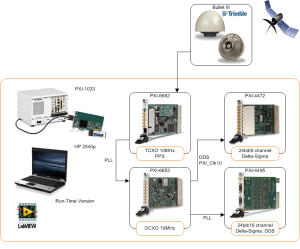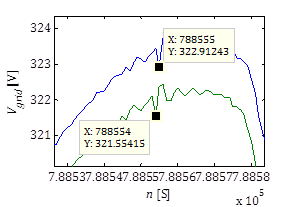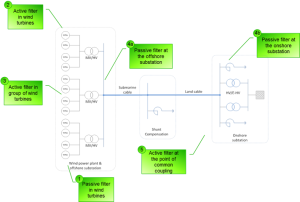There is clear need from various wind power industry shareholders such as transmission system operators (TSOs) and distribution network operators (DNOs), wind power plant (WPP) developers, wind turbine (WT) manufacturers, WT component suppliers, academic units, research institutions, certifying bodies and standardization groups (e.g. TC88 MT21) for having a standardized WT harmonic model.
The standard approach in representing a harmonic model would find a broad application in many areas of electrical engineering related to design, analysis, and optimization of WPP electrical infrastructure. Among others this could be evaluation of the WT harmonic performance, system-level harmonic studies, electrical infrastructure design and proposal of harmonic mitigation measures [1].
This starts to be even more important in such multi stakeholder systems as large offshore WPPs where TSOs, offshore transmission owners, component or sub-plant suppliers, WPP developers and operators as well as WT manufacturers need to have a common understanding about harmonic modelling of WTs and harmonic studies in WPPs. This is in relation of harmonic propagation and also harmonic small-signal stability studies.
A standardized approach of WT harmonic model representation is being addressed within IEC TC88 MT21 which will lead to release of IEC TR 61400-21-3 [2]. The structure of the harmonic model presented in the TR will find an application in the following potential areas:
- Evaluation of the WT harmonic performance during the design of electrical infrastructure and grid code compliance studies.
- Harmonic studies/analysis of modern power systems incorporating a number of grid-tied converters.
- Harmonic mitigation measure design by means of active or passive harmonic filtering to optimize electrical infrastructure as well as meet requirements in various grid codes.
- Sizing of electrical components (e.g. harmonic losses, static reactive power compensation, noise emission, harmonic compatibility levels, etc.) within WPP electrical infrastructure.
- WPP electrical infrastructure optimization on a system level, e.g. impedance/resonance characteristic shaping, planning levels definition and evaluation etc.
- Evaluation of external network background distortion impact on WT harmonic assessment as also addressed in IEC 61400-21-1 Annex D.
- Standardized communication interfaces in relation to WT harmonic data exchange between different stakeholders (e.g. system operators, generators, developers, etc.).
- Universal interface for harmonic propagation (and possibly stability) studies for engineering software developers.
- Possible benchmark of WT introduced to the academia and the industry.
The advantage of having standardized WT harmonic performance measure by means of the harmonic model is getting more and more crucial in case of large systems with different types of WT connected to them, e.g. multi-cluster WPPs incorporating different types of WT connected to the same offshore or onshore substation.
[1] Ł. H. Kocewiak, C. Álvarez, P. Muszynski, J. Cassoli, L. Shuai, “Wind Turbine Harmonic Model and Its Application – Overview, Status and Outline of the New IEC Technical Report,” in Proc. The 14th International Workshop on Large-Scale Integration of Wind Power into Power Systems as well as Transmission Networks for Offshore Wind Farms, Energynautics GmbH, 20-22 October 2015, Brussels, Belgium.
[2] IEC TR 61400-21-3:2016 (or 2017), Wind Energy Generation Systems – Part 21-3: Wind turbine harmonic model and its application.




